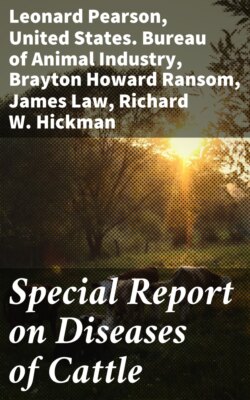Читать книгу Special Report on Diseases of Cattle - Lowe - Страница 44
На сайте Литреса книга снята с продажи.
INTESTINAL WORMS. [See chapter on "The animal parasites of cattle," p. 502.] RUPTURES (VENTRAL HERNIA).
ОглавлениеVentral hernia, or rupture, is an escape of some one of the abdominal organs through a rupture in the abdominal muscles, the skin remaining intact. The rumen, the small intestine, or part of the large intestine, and the fourth stomach are the parts which usually form a ventral hernia in bovine animals.
Causes.—Hernia is frequently produced by blows of the horns, kicks, and falls. In old cows hernia may sometimes occur without any direct injury.
Hernia of the rumen.—Hernia of the rumen is generally situated on the left side of the abdomen, on account of the situation of the rumen. In exceptional cases it may take place on the right side, and in such cases it also generally happens that some folds of the intestine pass into the hernial sac. Hernias have been classified into simple or complicated, recent or old, traumatic (from mechanical injury) or spontaneous.
In recent traumatic hernia there is swelling on the left side of the lower part of the abdomen. The swelling is greatest in the cases of hernia which are situated on the lower part of the abdomen. Unless an examination is made immediately after the injury has been inflicted it is difficult, and sometimes impossible, to ascertain the exact extent of the rupture, owing to the swelling which subsequently takes place. Frequently there is no loss of appetite, fever, or other general symptoms attending the injury. From the twelfth to the fifteenth day the swelling has generally subsided to such an extent that it is possible by an examination to determine the extent of the rupture.
In old cows what is termed spontaneous hernia may sometimes take place without any direct injury. The occurrence of this form of hernia is explained by the increase in the size of the abdomen, which takes place in an advanced stage of pregnancy, causing a thinning and stretching of the muscular fibers, which at last may rupture, or give way. Such hernias frequently occur about the end of the period of gestation, and in some instances have contained the right sac of the rumen, the omentum, the small and large intestines, a portion of the liver, and the pregnant uterus.
In old hernias the swelling is soft and elastic, and if they have not contracted adhesions to the sides of the laceration, they can be made to disappear by pressure carefully applied. Sometimes this accident is complicated by a rupture of the rumen, constituting a complicated hernia. If a portion of the contents of the rumen escape into the abdomen, the case will be aggravated by the occurrence of peritonitis.
Hernia of the bowel.—When the intestines (Pl. III, fig. 6) form the contents of the hernia, it will be situated at the right side of the abdomen. In an intestinal hernia the swelling is usually not painful, of a doughy consistence or elastic, according as the intestine does or does not contain alimentary matter. This swelling can generally be made to disappear by pressure, and when it has been reduced one can easily recognize the direction and extent of the hernial opening. Hernias of the bowel which are situated at the upper and right side of the abdomen are usually formed by the small intestine. They are less easily reduced than a hernia in a lower situation, but when reduction has been effected they are less readily reproduced than those occurring lower. In hernias of the small intestine, adhesion of the protruding parts to the walls of the opening, or strangulation, are complications which sometimes take place. If adhesion has taken place the hernia can not be reduced by pressure, and when strangulation has occurred the animal shows symptoms of pain—is restless, turns its nose to the painful part, and shows those symptoms which are usually collectively designated under the term colic. If relief is not afforded, the animal will die.
Hernia of the rennet, or fourth stomach.—This disease occasionally occurs in calves and is usually caused by a blow from a cow's horn on the right flank of the calf. After such an accident a swelling forms on the right flank near the last rib. This swelling may be neither hot nor painful, even at first, and is soft to the touch. It can be made to disappear by careful pressure, when the sides of the aperture through which it has passed can be felt. The application of pressure so as to cause the disappearance of the hernia is best made immediately after the occurrence of the accident, or when the edema which accompanies the swelling has disappeared.
Treatment.—When a hernia is reducible—that is, can be pushed back into the abdomen—then, if it is of recent occurrence, it is advisable to maintain the natural position of the parts by bandaging and to allow the walls of the laceration to grow together. The bowels should be kept reasonably empty by avoiding the use of bulky feed, and the animal must be kept quiet.
The following method of bandaging is recommended by Bouley:
